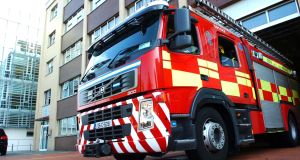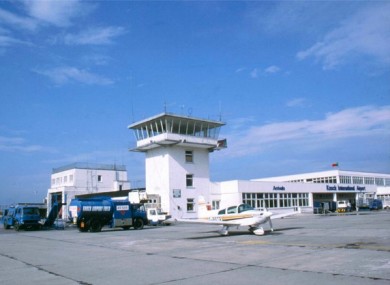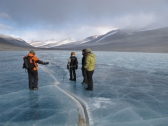IDA created more than 7,000 net jobs in 2013
THE NET NUMBER OF JOBS CREATED BY THE IDA IN 2013 BROKE THE 7,000 MARK – THE LARGEST JUMP IN MORE THAN A DECADE.
More than 161,000 people are now employed in multi-national companies attracted to Ireland by the IDA. It created 13,367 jobs but 6,296 jobs were also lost during the year.
The IDA is the semi-state agency responsible for attracting foreign direct investment into the country.
STRONG: It’s a strong result for chief executive Barry O’Leary, who steps down from the post later in the year.
His successor has not yet been selected, but he or she is expected to be in place by around the middle of the year.
“These will be my final set of results as chief executive of IDA as I intend to pursue other opportunities outside the organisation as soon as my successor is in place,” Mr O’Leary said.
“I wish to thank everyone, inside and outside the organisation, for their kind support during my time in the most fulfilling and stimulating of roles.”
Throughout the year 164 investments were won, up 13pc on 2012, and 78 new companies invested in Ireland for the first time. This is up 18pc on 2012.
While the record jobs numbers are a major boost for the agency, it struggles to meet its target of attracting foreign direct investment to the regions.
Mr O’Leary said the IDA would be building three buildings – two 25,000 sq ft manufacturing facilities in Waterford and Athlone – and an office building in Letterkenny.
It is the first time that the IDA has built a facility in four years.
The buildings will be marketed by the IDA in a bid to attract companies into those areas.
Mr O’Leary has been chief executive since 2008, having replaced former civil servant Sean Dorgan.
“At a certain point of time you have to step down from whatever job you’re in,” Mr O’Leary said.
Jobs Minister Richard Bruton described Mr O’Leary as a “tremendous leader”.
Mr Bruton said the hope is to exceed the job creation target in 2014.
Irish public to be asked if driverless cars is the correct road to take


A Google self-driving car at the Google headquarters in Mountain View, California & a gentleman waves from a self-driving car.
Irish drivers and passengers will be asked for their opinions on ‘driverless cars’ before they are licensed for use here.
The Road Safety Authority (RSA) is promising to hold a public consultation process before any decision is made to allow driverless cars to be tested on the roads.
There is growing momentum behind driverless cars, with Britain giving the go-ahead for them to be tested on its public roads as long as there is a driver in the vehicle in the event of an emergency.
Google’s driverless car has now driven more than 500,000 miles in the US without causing an accident – about twice as far as the average American driver goes before crashing.
Driverless cars containing sensors and guided by satellite navigation systems have been hailed as having the potential to reduce the 1.2 million people killed in car accidents every year worldwide. And they could have benefits for rural pubs whose customers could get home without fear of failing the drink driving test.However, the RSA has adopted a cautious approach and warned that they are still a “long way off” in this country.
RSA spokesman Brian Farrell said the crucial issue would be the safety of driverless cars.
LIABLE: “There needs to be strong legislation to support it, not just in Ireland but in the EU as well,” he said.
Such legislation would have to deal with issues such as whether the driver would still be legally liable if there was a minor or even fatal accident involving their driverless car. And any driverless cars going on the roads also have to get approval from the EU.
Mr Farrell promised there would be a public consultation process on driverless cars before any trials were carried out here. He said it would take some time before driverless cars become the norm on public roads.
“More development and trials will be required to help the technology mature and to prove the reliability of such systems to ensure that public safety is not compromised,” he said.
Google Ireland spokeswoman Celine Crawford said the company currently had no plans to test its Google Car here.
Irish people in denial about their dental health care

Four out of five Irish people think their teeth and gums are healthy and look good – however, the reality is somewhat different as people are now visiting the dentist far less often than they used to.
A new survey has found 23% of people are visiting the dentist less often since 2010 while nearly 60% of those surveyed said they would only consider visiting the dentist in an emergency.
According to the survey of 750 adults, which was carried out for the Irish Dental Association (IDA), 46% of Irish people are spending less on dental health while 41% rarely if ever think of visiting their dentist.
IDA Chief Executive Fintan Hourihan said the survey showed the impact the recession was having on dental health as well as a ‘disconnect’ between what people think and how they act.
“One in four Irish people are attending the dentist less often. In population terms this equates to 760,000 adults. It’s clear this is having a hugely negative impact on the dental health of the population. While over 80% believe their gums are healthy, according to the most recent national oral health survey, 80% of Irish people have some form of gum disease.”
The survey found that while 94% of respondents said they thought dental health was important almost 60% said they would only attend a dentist when they really need to or in an emergency.
“Financial pressures are definitely a factor here but so also is the lack of information from the HSE. The survey shows that only half of Irish adults are aware of their State dental entitlement of a free check up and only one in three have availed of it,” Mr Hourihan said.
He called for a restoration of the dental cover benefits which were previously available under the medical card and PRSI schemes but were withdrawn due to Government cutbacks.
Early screening test for pre-eclampsia being developed by Irish startup
The bioscience company has received three-quarters of a million euro to develop what it calls “breakthrough blood test”.is shown how the blood test works.
An Irish Bio-science company has secured €750,000 to develop a test which could detect pre-eclampsia risk in pregnant women at an early stage of their pregnancy.
Pre-eclampsia can be a fatal condition and doesn’t generally make itself known until the second half of the term of pregnancy. At that time, the only treatment option should it escalate (the high blood pressure symptom can be incredibly dangerous for mother and baby) can be early delivery of the baby.
Irish start-up Metabolomic Diagnostic is developing a blood test called ‘PrePsia’ which it is hoped will detect women at high risk of developing pre-eclampsia, allowing for early treatment before the condition deteriorates.
Junior minister for research and innovation, Seán Sherlock, said that the investment from Enterprise Ireland, AIB Seed Capital Fund and SOSventures Ireland Fund is vital. He said:
This is an important investment, given the potential significance of this metabolomic diagnostic test, the results of which include saving lives.
There are currently 5,000 pregnant women from all over Europe involved in giving blood specimens to test Metabolomic Diagnostics technology.
The company is based in Little Island in Cork.
For those seeking further information, clarification and support on pre-eclampsia, visit preeclampsia.org, the website of the Pre-eclampsia Foundation, a registered charity and patient advocacy group.
Fire near Knock airport under control


A fire at an industrial unit in a business park, close to Ireland West Airport in Knock, Co Mayo has been brought under control.
The building has been extensively damaged but there are no reports of any injuries. Fire service personnel were alerted to the blaze at the detached unit, just after 6.30pm.
All scheduled arrivals and departures to the nearby airport had been completed by the time the fire broke out.
Fire fighters have been dispatched from Swinford, Charlestown and Ballaghaderreen.
It is understood the factory where the blaze broke out is located on the Old Airport road. The premises is no longer occupied.
5 Antarctic facts for climate change sceptics

Five indisputable truths for sceptics who say that MV Akademik Shokalskiy’s ‘failed’ mission disproves scientific theories on ice
To most people the prolonged stranding of the MV Akademik Shokalskiy in thick pack ice off the coast of Antarctica is an unfortunate incident that provided passengers with rather static scenery for their Christmas and New Year celebrations.
But to some climate change contrarians, repeated attempts to free the vessel from the ice are proof that the theory of climate change is flawed or, at best, exaggerated. After all, a warming planet has no ice at all, right?
In Sydney’s Daily Telegraph, Roger Franklin dispensed with analysis of ice extent, the cyrosphere and the like to get to the heart of the matter – expedition leader Chris Turney is a “warmist” whose understanding of Antarctica amounts to little more than it gets “really, really cold”.
The Australian newspaper darkly intoned that the stranding was a “hard lesson for those who persistently exaggerate the impact of global warming”.
Helpfully, the newspaper said that researchers aboard the Akademik Shokalskiy have suffered an “embarrassing failure” in their mission, which apparently was not to follow in the footsteps of explorer Douglas Mawson and build on his scientific observations but to prove beyond doubt that climate change is real.
ABC science broadcaster Adam Spencer took to Twitter to lament that “you’d fail a year 8 science test if you presented the misunderstandings” contained in The Australian‘s editorial. To help clear up the confusion, here are some basic Antarctic facts.
1. It is large and cold
 The Antarctic is an enormous frozen continent that covers about a fifth of the southern hemisphere. It is the driest, windiest continent on Earth, covered by ice that can reach 4 kilometres deep.
The Antarctic is an enormous frozen continent that covers about a fifth of the southern hemisphere. It is the driest, windiest continent on Earth, covered by ice that can reach 4 kilometres deep.
A new world record for a low temperature was set in December when a NASA satellite clocked a reading of minus 93.3 degrees Celsius on the east Antarctic plateau.
Surrounding the vast glacial, or land-based, ice is sea ice, which contracts and expands depending on the season. This is an important distinction, which we will get to shortly.
2. It is not the same as the Arctic
Essentially, the Antarctic is a continent of ice surrounded by cold water.
The Arctic is a semi-enclosed ocean, almost completely surrounded by land. Steadily warming land and sea temperatures have had a visible impact on the Arctic, with its extent reaching record lows in recent years.
The loss of ice in Antarctica does not appear to be as dramatic and it is even increasing in places, leading some to believe this means global warming is not occurring.
“When people talk about an increase in ice they are actually talking about sea ice, which is completely different from continental ice. Warmer oceans help melt the ice and make it thinner, which has been observed in the Arctic. In Antarctica it’s more complicated. It is losing continental ice while sea ice has been increasing by about 1 per cent a decade,” said Tony Press, chief executive of the Antarctic Climate and Ecosystems Co-operative Research Centre based at the University of Tasmania.
3. Climate change is having varying impacts
 Studies have found Antarctica has lost about 100 billion tonnes of continental ice a year since 1993, causing the global sea level to rise by about 0.2mm a year.
Studies have found Antarctica has lost about 100 billion tonnes of continental ice a year since 1993, causing the global sea level to rise by about 0.2mm a year.
The latest climate report from the Intergovernmental Panel on Climate Change, released last year, said there was “high confidence” that the Antarctic ice sheet had been losing ice during the past two decades.
But this loss, caused by warming oceans, has been countered by an increase in ice in the Ross Sea region. This is the result of a range of factors, including climate change.
4. The ship did not get “frozen in”
It was pinned by ice from the Mertz glacier, a well-established ice formation.
“In the last few years the ice near where the ship is bogged has become less accessible,” Press said. “This will eventually break up and move away, depending on wind patterns, storms, tidal activity and ambient temperatures. These are variable, local conditions.”
5. Research takes time
The Australian Antarctic Division has been collecting data on ice flow, thickness and other such things in east Antarctica for more than 50 years.
Despite this, the organisation admits there are still gaps in scientific understanding of the Antarctic, mainly around the dynamics of ice sheets. This understanding will be improved by rigorous analysis of gathered evidence.
It’s unlikely a single ship getting stuck in ice will cause a major deviation in researchers’ findings.




No comments:
Post a Comment